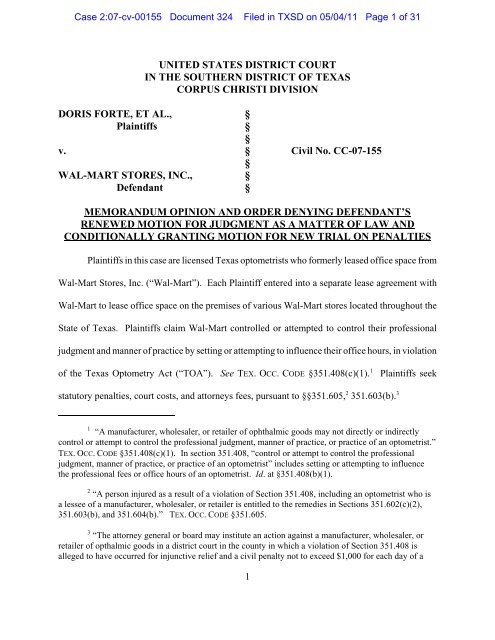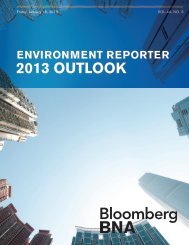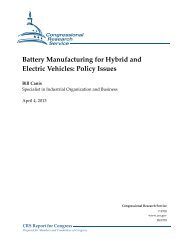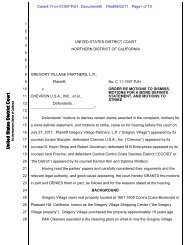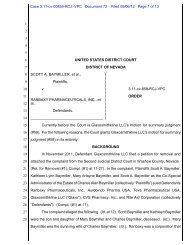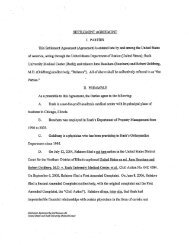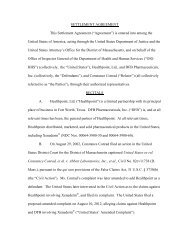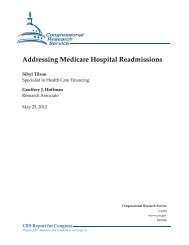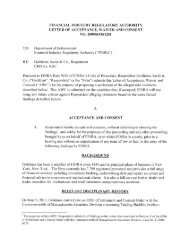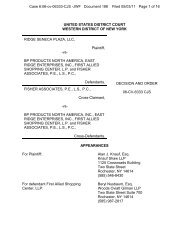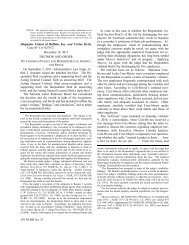N:\Amber Henderson\7-cv-155 Forte v. Walmart\FINAL ... - BNA
N:\Amber Henderson\7-cv-155 Forte v. Walmart\FINAL ... - BNA
N:\Amber Henderson\7-cv-155 Forte v. Walmart\FINAL ... - BNA
You also want an ePaper? Increase the reach of your titles
YUMPU automatically turns print PDFs into web optimized ePapers that Google loves.
Case 2:07-<strong>cv</strong>-00<strong>155</strong> Document 324 Filed in TXSD on 05/04/11 Page 1 of 31<br />
UNITED STATES DISTRICT COURT<br />
IN THE SOUTHERN DISTRICT OF TEXAS<br />
CORPUS CHRISTI DIVISION<br />
DORIS FORTE, ET AL., §<br />
Plaintiffs §<br />
§<br />
v. § Civil No. CC-07-<strong>155</strong><br />
§<br />
WAL-MART STORES, INC., §<br />
Defendant<br />
§<br />
MEMORANDUM OPINION AND ORDER DENYING DEFENDANT’S<br />
RENEWED MOTION FOR JUDGMENT AS A MATTER OF LAW AND<br />
CONDITIONALLY GRANTING MOTION FOR NEW TRIAL ON PENALTIES<br />
Plaintiffs in this case are licensed Texas optometrists who formerly leased office space from<br />
Wal-Mart Stores, Inc. (“Wal-Mart”). Each Plaintiff entered into a separate lease agreement with<br />
Wal-Mart to lease office space on the premises of various Wal-Mart stores located throughout the<br />
State of Texas. Plaintiffs claim Wal-Mart controlled or attempted to control their professional<br />
judgment and manner of practice by setting or attempting to influence their office hours, in violation<br />
of the Texas Optometry Act (“TOA”). See TEX. OCC. CODE §351.408(c)(1). 1<br />
Plaintiffs seek<br />
statutory penalties, court costs, and attorneys fees, pursuant to §§351.605, 2 351.603(b). 3<br />
1<br />
“A manufacturer, wholesaler, or retailer of ophthalmic goods may not directly or indirectly<br />
control or attempt to control the professional judgment, manner of practice, or practice of an optometrist.”<br />
TEX. OCC. CODE §351.408(c)(1). In section 351.408, “control or attempt to control the professional<br />
judgment, manner of practice, or practice of an optometrist” includes setting or attempting to influence<br />
the professional fees or office hours of an optometrist. Id. at §351.408(b)(1).<br />
2 “A person injured as a result of a violation of Section 351.408, including an optometrist who is<br />
a lessee of a manufacturer, wholesaler, or retailer is entitled to the remedies in Sections 351.602(c)(2),<br />
351.603(b), and 351.604(b).” TEX. OCC. CODE §351.605.<br />
3<br />
“The attorney general or board may institute an action against a manufacturer, wholesaler, or<br />
retailer of opthalmic goods in a district court in the county in which a violation of Section 351.408 is<br />
alleged to have occurred for injunctive relief and a civil penalty not to exceed $1,000 for each day of a<br />
1
Case 2:07-<strong>cv</strong>-00<strong>155</strong> Document 324 Filed in TXSD on 05/04/11 Page 2 of 31<br />
In August, 2010, the parties tried the claims of Plaintiffs Doris <strong>Forte</strong>, John Boldan, David<br />
Wiggins, and Bridget LeeSang (“Plaintiffs”) to a jury. 4 After four days of trial, the jury entered a<br />
verdict against Wal-Mart. Specifically, the jury found that Wal-Mart controlled or attempted to<br />
control Plaintiffs’ professional judgment, manner of practice, or optometrical practice by setting or<br />
attempting to influence their office hours. The jury also found that Wal-Mart’s conduct injured<br />
Plaintiffs and awarded them an aggregate civil penalty of $3,953,000.00. 5 See D.E. 276.<br />
Pending before the Court is Wal-Mart’s renewed motion for judgment as a matter of law and<br />
alternative requests for new trial or a remittitur, brought pursuant to FED. R. CIV. P. 50(b). See D.E.<br />
300. On January 26, 2011, the Court heard the parties’ oral argument on the motion. For the reasons<br />
explained below, Wal-Mart’s renewed motion for judgment as a matter of law is DENIED and<br />
motion for new trial on penalties is GRANTED, unless Plaintiffs consent to a partial reduction of<br />
their penalty awards to $ 400.00 for each day of a violation, i.e. each day Plaintiffs represented in<br />
their individual lease agreements with Wal-Mart that they would operate their practice.<br />
I. Renewed Motion for Judgment as a Matter of Law<br />
Pursuant to FED. R. CIV. P. 50(b), Wal-Mart first argues there is no legally sufficient<br />
evidentiary basis to substantiate the jury’s liability finding against Wal-Mart. Wal-Mart contends<br />
the conduct alleged by Plaintiffs does not constitute a violation of the TOA. Specifically, Wal-Mart<br />
argues the lease agreement provision at issue, which required Plaintiffs to represent their intended<br />
violation plus court costs and reasonable attorney’s fees.” Id. at §351.603(b).<br />
4 The claims of Plaintiffs Sylvia Brown, Sherri Fauver Rast, Marcus Hood, Ghassen Atashi Rang,<br />
John Rivera, Bernard Maslovitz, Doan-Ahn Pham, and Ron Mixon are still pending.<br />
5<br />
The jury awarded $1,075,000.00 to Doris <strong>Forte</strong>, O.D., $1,240,000.00 to David Wiggins, O.D.,<br />
$1,456,000.00 to John Boldan, O.D., and $182,000.00 to Bridget LeeSang, O.D.<br />
2
Case 2:07-<strong>cv</strong>-00<strong>155</strong> Document 324 Filed in TXSD on 05/04/11 Page 3 of 31<br />
hours of operation within the lease agreement, was not an enforceable condition of the leases, and<br />
therefore, does not constitute an attempt by Wal-Mart to influence Plaintiffs’ office hours. Apart<br />
from the written lease agreements themselves, Wal-Mart contends there is no legally sufficient<br />
evidence that it engaged in any other conduct that violated the TOA. Wal-Mart also argues that<br />
allowing judgment on the jury’s verdict would violate Wal-Mart’s state and federal due process rights<br />
because the TOA is unconstitutionally vague and did not provide fair notice to Wal-Mart that its<br />
conduct violated the TOA. The Court disagrees.<br />
A. Applicable Law<br />
“A motion for judgment as a matter of law ... in an action tried by jury is a challenge to the<br />
legal sufficiency of the evidence supporting the jury’s verdict.” Navigant Consulting, Inc. v.<br />
Wilkinson, 508 F.3d 277, 283 (5th Cir. 2007) (citing Flowers v. S. Reg’l Physician Servs., Inc., 247<br />
F.3d 229, 235 (5th Cir. 2001)). In deciding such motions, the district court applies the standard<br />
established in Boeing Co. v. Shipman, 411 F.2d 365 (5th Cir. 1969) (en banc), overruled on other<br />
grounds, 107 F.3d 331, 336 (5th Cir. 1997). Urban Developers LLC v. City of Jackson, Miss., 468<br />
F.3d 281, 296–97 (5th Cir. 2006) (citing Boeing, 411 F.2d at 374). Boeing instructs the Court to<br />
consider all of the evidence in the light and with all reasonable inferences most favorable to the party<br />
opposed to the motion. Boeing, 411 F.2d at 374. If the facts and inferences point so strongly and<br />
overwhelmingly in favor of one party that the Court believes that reasonable men could not arrive<br />
at a contrary verdict, granting the motion is proper. Id. On the other hand, if there is substantial<br />
evidence opposed to the motions, that is, evidence of such quality and weight that reasonable and<br />
fair-minding men in the exercise of impartial judgment might reach different conclusions, the motion<br />
should be denied. Id.<br />
3
Case 2:07-<strong>cv</strong>-00<strong>155</strong> Document 324 Filed in TXSD on 05/04/11 Page 4 of 31<br />
B. Analysis<br />
The TOA explicitly prohibits a retailer of ophthalmic goods, such as Wal-Mart, from directly<br />
or indirectly controlling or attempting to control the professional judgment, manner of practice, or<br />
practice of an optometrist. TEX. OCC. CODE §351.408(c)(1). The statute clearly defines “control or<br />
attempt to control” to include setting or attempting to influence the office hours of an optometrist.<br />
Id. at §351.408(b)(1). During the four-day trial, the jury heard the live testimony of Plaintiffs and<br />
Wal-Mart’s corporate representatives and employees concerning the details surrounding the<br />
formation, renewal, and non-renewal of the various lease agreements at issue in this case. The Court<br />
also admitted into evidence various internal corporate documents by Wal-Mart, including letters, e-<br />
mails, and memoranda, along with the written lease agreements themselves and Wal-Mart’s<br />
stipulation that it required “as a condition to obtain or renew a license agreement” that Plaintiffs<br />
represent their weekly hours of coverage to patients. See D.E. 301-1.<br />
Considering all of the evidence in the light and with all reasonable inferences in favor of<br />
Plaintiffs, the Court finds there is legally sufficient evidence to substantiate the jury’s verdict on<br />
liability. The Court finds reasonable and fair-minding men could conclude from the evidence that<br />
Wal-Mart unlawfully attempted to influence Plaintiffs’ office hours. Wal-Mart’s renewed motion<br />
for judgment as a matter of law is therefore DENIED.<br />
4
Case 2:07-<strong>cv</strong>-00<strong>155</strong> Document 324 Filed in TXSD on 05/04/11 Page 5 of 31<br />
II.<br />
Motion for New Trial or a Substantial Remittitur<br />
In the alternative, also pursuant to Rule 50(b), 6 Wal-Mart moves for a new trial or, in the<br />
second alternative, a substantial remittitur of the penalties awarded by the jury. Wal-Mart argues:<br />
(1) the penalties awarded are excessive under Texas law; (2) the penalties awarded “shock the<br />
conscience” and were a result of the jury’s bias or prejudice; (3) the penalties awarded are so<br />
excessive that they violate federal and state due process standards; (4) the jury miscalculated the<br />
penalties; and (5) the jury was confused and misunderstood the law. For the reasons explained<br />
below, the Court finds the penalties awarded to Plaintiffs by the jury are excessive under Texas law.<br />
The court finds all other arguments raised by Wal-Mart in support of its motion for new trial or<br />
remittitur have no merit and are OVERRULED.<br />
A. Applicable Law<br />
Rule 59 provides that, after a jury trial, a court may grant a new trial on all or some of the<br />
issues, and to any party, “for any reason for which a new trial has heretofore been granted in an<br />
action at law in federal court ... ” FED. R. CIV. P. 59(a)(1)(A). For example, a new trial may be<br />
granted if the district court finds the damages awarded are excessive. Beckham v. Louisiana Dock<br />
Co., L.L.C., 124 Fed. Appx. 268, 270 (5th Cir. 2005) (citing Smith v. Transworld Drilling Company,<br />
773 F.2d 610, 612 (5th Cir. 1985)); Westbrook v. General Tire and Rubber Co., 754 F.2d 1233, 1241<br />
(5th Cir. 1985). Having determined that an award is excessive, the trial court may either order a new<br />
trial on damages or may give the plaintiff the option of avoiding a new trial by agreeing to a remittitur<br />
6<br />
Rule 50(b) provides that “No later than 28 days after the entry of judgment – or if the motion<br />
addresses a jury issue not decided by a verdict, no later than 28 days after the jury was discharged – the<br />
movant may file a renewed motion for judgment as a mater of law and may include an alternative or joint<br />
request for a new trial under Rule 59.” FED. R. CIV. P. 50(b).<br />
5
Case 2:07-<strong>cv</strong>-00<strong>155</strong> Document 324 Filed in TXSD on 05/04/11 Page 6 of 31<br />
of the excessive portion of the award. Hernandez v. M/V Rajaan, 841 F.2d 582, 587 (5th Cir. 1988)<br />
(citing Osburn v. Anchor Laboratories, Inc., 825 F.2d 908, 919 (5th Cir. 1987)). See also Gorsalitz<br />
v. Olin Mathieson Chemical Corp., 429 F.2d 1033, 1042-43 (5th Cir. 1970).<br />
In an action such as this, which is based on state law but tried in federal court by reason of<br />
diversity of citizenship, a district court must apply a new trial or remittitur standard according to the<br />
state’s law controlling jury awards for excessiveness or inadequacy. Foradori v. Harris, 523 F.3d<br />
477, 497 (5th Cir. 2008) (citing Gasperini v. Center for Humanities, Inc., 518 U.S. 415, 116 S.Ct.<br />
2211, 135 L.Ed.2d 659 (1996)). 7 In Texas, the standard of review for an excessive damages<br />
complaint is factual sufficiency of the evidence. Maritime Overseas Corp. v. Ellis, 971 S.W.2d 402,<br />
406 (Tex. 1998) (citing Rose v. Doctors Hosp., 801 S.W.2d 841, 847-48 (Tex. 1990)); See also Pope<br />
v. Moore, 711S.W.2d 622, 624 (Tex. 1986) (Factual sufficiency is the sole remittitur standard for<br />
actual damages).<br />
In determining whether damages are excessive, trial courts and courts of appeal employ the<br />
same test as for any factual insufficiency question. Id. (citing Flanigan v. Carswell, 159 Tex. 598,<br />
324 S.W.2d 835, 840 (1959)). A court of appeals may vacate a damage award or suggest a remittitur<br />
only if the award is “so factually against the great weight and preponderance of the evidence as to<br />
be manifestly unjust.” Transp. Ins. Co. v. Meriel, 879 S.W.2d 10, 30 (Tex. 1994) (quoting Pope, 711<br />
S.W.2d at 624). When considering a factual sufficiency challenge to a jury’s verdict, courts of<br />
appeals must consider and weigh all of the evidence, not just that evidence which supports the<br />
verdict. Ellis, 971 S.W.2d at 407 (citing Ortiz v. Jones, 817 S.W.2d 770, 772 (Tex. 1996); Lofton v.<br />
7 Under the Erie doctrine, federal courts sitting in diversity apply state substantive law and federal<br />
procedural law. Foradori v. Harris, 523 F.3d 477, 497 (5th Cir. 2008) (citing Gasperini v. Center for<br />
Humanities, Inc., 518 U.S. 415, 116 S.Ct. 2211, 135 L.Ed.2d 659 (1996)).<br />
6
Case 2:07-<strong>cv</strong>-00<strong>155</strong> Document 324 Filed in TXSD on 05/04/11 Page 7 of 31<br />
Texas Brine Corp., 720 S.W.2d 804, 805 (Tex. 1986).<br />
B. Analysis<br />
The TOA provides that a person injured as a result of a violation of section 351.408, including<br />
an optometrist who is a lessee of a retailer, is entitled to institute an action for a civil penalty not to<br />
exceed $1,000 for each day of a violation. See TEX. OCC CODE §§351.605, 351.603(b). The statute<br />
provides that each day a violation continues or occurs is a separate violation. Id. at §351.552(a). The<br />
statute also mandates that the amount of penalty shall be based on the following factors: (1) the<br />
seriousness of the violation, including the nature, circumstances, extent, and gravity of any prohibited<br />
acts, and the hazard or potential hazard created to the health, safety, or economic welfare of the<br />
public; (2) the economic harm to property or the environment caused by the violation; (3) the history<br />
of previous violations; (4) the amount necessary to deter a future violation; (5) efforts to correct the<br />
violation; and (6) any other matter that justice may require. Id. at §351.552(b).<br />
It is apparent to the Court and parties that the jury awarded Plaintiffs the maximum civil<br />
penalty available under the statute, i.e. $1,000.00 for each day Plaintiffs represented in their<br />
individual lease agreements with Wal-Mart that they would keep their clinic open and provide<br />
coverage to patients. The Court has reviewed and weighed the evidence and finds it is factually<br />
insufficient to support imposing the maximum civil penalty for each day of a violation. To enter<br />
judgment on the jury’s penalty awards against Wal-Mart would be manifestly unjust because, as<br />
explained below, the evidence, when properly evaluated under the statutory factors, supports<br />
imposition of a substantially smaller, but nonetheless significant, penalty.<br />
7
Case 2:07-<strong>cv</strong>-00<strong>155</strong> Document 324 Filed in TXSD on 05/04/11 Page 8 of 31<br />
1. Seriousness of the violation, including the nature, circumstances, extent, and<br />
gravity of any prohibited acts, and the hazard or potential hazard created to the<br />
health, safety, or economic welfare of the public<br />
The statutory purposes of the TOA, on which the Court instructed the jury, are to safeguard<br />
the visual welfare of the public and the doctor-patient relationship. 8 See TEX. OCC. CODE<br />
§351.363(a).<br />
In this case, there was no evidence that the visual welfare of the public or the<br />
Plaintiffs’ professional relationships with their patients were actually compromised by Wal-Mart’s<br />
conduct. There was no evidence that Plaintiffs, as a result of Wal-Mart’s conduct, were required to<br />
work to such a degree that they or their patients’ health were placed in jeopardy.<br />
The Court acknowledges the testimony of Drs. Wiggins, Boldan, and <strong>Forte</strong> concerning the<br />
potential impact that Wal-Mart’s conduct could have had on their doctor-patient relationships. All<br />
three testified that Wal-Mart’s conduct, by asking them to list their intended hours of coverage in the<br />
lease agreements, had the potential to influence and interfere with their professional judgement and<br />
thereby affect their professional relationships with their patients. For example, when asked by Mr.<br />
Cowles, counsel for Wal-Mart, whether Wal-Mart had ever interfered with her professional exams<br />
and treatment of patients, Dr. <strong>Forte</strong> testified as follows:<br />
You know, simply by virtue of the fact that Wal-Mart was persistently involved with<br />
how I managed my time in that space. And that does affect, you know, as much as<br />
I hate to say that, it does affect my professional exam and how I managed my practice.<br />
You know, I had to do a lot of rescheduling at times to accommodate the flow of<br />
8<br />
The Court instructed the jury as follows: “The State of Texas has passed a statute to regulate<br />
the relationships that doctors of optometry have with their patients and others. The stated purposes of the<br />
statute are to safeguard the visual welfare of the public and the doctor-patient relationship, assign<br />
professional responsibility, establish professional standards of professional surroundings, more nearly<br />
secure to the patient the optometrist’s or therapeutic optometrist’s undivided loyalty and service, and<br />
carry out the prohibitions against placing an optometric or therapeutic optometric license in the service or<br />
at the disposal of an unlicenced person. This applies to an optometrist or therapeutic optometrists who<br />
leases space from and practices optometry or therapeutic optometry on the premises of a mercantile<br />
establishment.” See D.E. 272, page 7.<br />
8
Case 2:07-<strong>cv</strong>-00<strong>155</strong> Document 324 Filed in TXSD on 05/04/11 Page 9 of 31<br />
patients and walk-ins and I’m not saying I wasn’t grateful for the business, but being<br />
adjacent to a Wal-Mart had its own built-in problems.<br />
None of the Plaintiffs testified about a particular instance where the pressure to work<br />
influenced their professional medical judgment or where their listed hours caused harm to their<br />
patients or caused Plaintiffs to provide them substandard medical care. No patients came forward<br />
to testify or complain about the standard of care they received from Plaintiffs, and there was no<br />
expert testimony offered to explain how Wal-Mart’s conduct did or could potentially cause any actual<br />
harm to the public.<br />
2. Economic harm to property or the environment caused by the violation<br />
It is undisputed that, in their pleadings and at trial, Plaintiffs disclaimed that they have<br />
suffered any actual damages as a result of Wal-Mart’s conduct. Accordingly, the Court specifically<br />
instructed the jury on that issue without Plaintiffs’ objection:<br />
Plaintiffs do not claim they have sustained any physical or economic damages as a<br />
result of Wal-Mart’s conduct. Plaintiffs only seek to recover civil penalties from<br />
Wal-Mart for each day of a violation.<br />
Remember, that Plaintiffs do not seek to recover any actual damages. You may not<br />
award civil penalties in order to compensate Plaintiffs for any physical or economic<br />
loss they may have sustained. See D.E. 272.<br />
Plaintiffs reiterated in their live testimony that they are not seeking to recover any actual<br />
damages in this case. Dr. Boldan testified that he was not seeking any actual damages for lost profits<br />
or mental anguish. Drs. Wiggins and LeeSang likewise testified that they are not seeking to recover<br />
any actual damages they may have sustained as a result of Wal-Mart’s conduct. Dr. <strong>Forte</strong> testified<br />
that she was not seeking any remedies or actual damages as a result of Wal-Mart’s ultimate decision<br />
to not renew her lease agreement. In fact, when Mr. Cowles asked Dr. <strong>Forte</strong> if she was seeking a<br />
penalty against Wal-Mart for every day of the five years of leases she had with Wal-Mart, Dr. <strong>Forte</strong><br />
9
Case 2:07-<strong>cv</strong>-00<strong>155</strong> Document 324 Filed in TXSD on 05/04/11 Page 10 of 31<br />
responded as follows:<br />
No, that’s not true. That’s what the statute says. That’s what’s allowed. What I’m<br />
seeking – what my purpose for being here is – I’m so happy to have an opportunity<br />
to speak to an unbiased group of people in a court to determine if they think that any<br />
of that is fair according to the law that Wal-Mart continues to arrogantly violate.<br />
I’m not seeking anything personally, okay? But the statute that Wal-Mart violates<br />
allows some penalty to be awarded and I’m going to let the jury decide what that is.<br />
3. History of previous violations<br />
The evidence demonstrates that Wal-Mart has previously violated the TOA. It is undisputed<br />
that prior to 1995, Wal-Mart included a liquidated damage provision in their Texas lease form.<br />
Under that provision, if a doctor failed to provide his contractual hours of coverage, he would be<br />
required, at the discretion of his district manager, to pay “$200.00 per day as liquidated damages for<br />
such failure.” Wal-Mart also required doctors to include Wal-Mart as an additional named insured<br />
in their professional liability insurance policies.<br />
In 1995, David Spivey, O.D., requested the Texas Optometry Board to review the legality of<br />
those provisions contained within his lease agreement with Wal-Mart. In a response letter to him<br />
dated February 21, 1995, the Texas Optometry Board concluded and advised Dr. Spivey that the<br />
liquidated damages provision “appears to be in violation” of the TOA and that the insurance<br />
provision “would be in violation” of same. See Defendant’s Exhibit 39. The Texas Optometry Board<br />
also explained that it had “shared these concerns verbally with representatives of Wal-Mart.” Id.<br />
In 2001, in response to a complaint made by Terry Schitoskey, O.D., about certain behavior<br />
of Wal-Mart “managers,” the Texas Optometry Board advised Dr. Schitoskey that it had “instructed<br />
the Legal Department of Wal-Mart that certain activities would be considered the control of<br />
optometry and illegal under the Optometry Act.” See Defendant’s Exhibit 48. In a response letter<br />
10
Case 2:07-<strong>cv</strong>-00<strong>155</strong> Document 324 Filed in TXSD on 05/04/11 Page 11 of 31<br />
dated January 5, 2001, Pauline Tureman, Director of Professional Services for Wal-Mart, Optical<br />
Division, advised Chris Kloeris, Legal Counsel for the Texas Optometry Board, the following:<br />
Our investigation revealed that our managers were trying to serve our customers’<br />
needs to the best of their abilities. The managers did inform the doctor of requests<br />
made by customers for lower prices and longer hours of operation. Wal-Mart<br />
absolutely agrees and understands that the ultimate decision regarding the hours and<br />
fees for eye examinations are made by the doctors. To the extent that Dr. Schitoskey<br />
believes our managers were imposing their judgment on hours and fees over his own<br />
judgment, we sincerely apologize. See Defendant’s Exhibit 46.<br />
Laura Meyer and Jay Udovitsch, a District Manager for Wal-Mart, testified that from 1995<br />
to 2008, Wal-Mart used the same lease form with all Texas optometrists. Every lease agreement<br />
procured by Wal-Mart during that time included a provision that required doctors to represent, i.e.<br />
list within the contract, their intended hours and days of operation. However, according to Angela<br />
Muldoon’s testimony, neither the Texas Optometry Board nor a court has ever concluded or ruled<br />
that the Texas lease form at issue in this case is unlawful. In fact, in a letter dated April 7, 1995, from<br />
the Texas Optometry Board to Hans Oosterbaan, O.D., the Board explained the following concerning<br />
his lease with Wal-Mart:<br />
The lease agreement you have forwarded does not appear to be in compliance with<br />
Section 5.11 of the Texas Optometry Act. Although it appears that the licensor (Wal-<br />
Mart) has made several changes in the agreement, of primary concern then and within<br />
the current document forwarded is language regarding the setting of hours of the<br />
practice of the optometrist, as well as the requirement of naming Wal-Mart, a retail<br />
optical, as an additional named insured under the optometrist’s professional liability<br />
insurance policy. Theses items were discussed with Wal-Mart but the language<br />
currently being used has neither been approved nor disapproved by the Texas<br />
Optometry Board. See Defendant’s Exhibit 84.<br />
In 2001, Wal-Mart threatened to terminate its lease agreement with Larry Decker, O.D., who,<br />
at the time, was leasing space at the Wal-Mart store in Sulphur Springs, Texas. In a letter to him<br />
dated September 20, 2001, Jay Udovitsch advised Dr. Decker that his lease would be terminated for<br />
11
Case 2:07-<strong>cv</strong>-00<strong>155</strong> Document 324 Filed in TXSD on 05/04/11 Page 12 of 31<br />
failing to comply with Section III of the lease, i.e. for failing to use his best efforts to provide his<br />
weekly hours of coverage to his patients. See Plaintiffs’ Exhibits 17, 18. In her testimony, Laura<br />
Meyer admitted that such conduct was unlawful but explained that issuing the letter was a mistake,<br />
one that was ultimately corrected by Wal-Mart. 9<br />
In 2004, Laura Meyer requested guidance from Robert Newell, who worked in Wal-Mart’s<br />
Legal Department, about an issue regarding Dr. Wiggins’s office hours:<br />
For the hours, the contract requires 6 days coverage but the dr is now only working<br />
2 days a week. Again, because this is Texas, the DM [District Manager] does not<br />
know if she can push the doctor to increase coverage. Please review the following<br />
information and let us know what our options are. See Plaintiffs’ Exhibit 118.<br />
Laura Meyer testified that she knew she couldn’t “push” Wiggins on coverage, but in an e-mail to<br />
her from supervisor Stephanie Spivey, Professional Services Manager, Optical Division, Meyer is<br />
instructed otherwise:<br />
We won’t be able to get this [15 day] letter out until Monday. We will address the<br />
rent and the hours in the letter. If he fails to work his contracted hours or pay rent<br />
beginning with Day 16 (after the 15 Day letter has run), then we will have the ability<br />
to terminate the Lease. See Plaintiffs’ Exhibit 22.<br />
Meyer admitted these discussions were improper, but explained that the 15-day letter ultimately<br />
received by Dr. Wiggins did not include his failure to provide coverage as a reason for potential<br />
termination.<br />
In her video deposition, Shawna Ledsome, who previously worked as a Professional Services<br />
Recruiter for Wal-Mart, testified that she recruited doctors to work for Wal-Mart and negotiated<br />
various lease agreements with them. She testified that Chic Leehan, who was then acting as her<br />
9 Although Dr. Decker did receive a termination letter from Wal-Mart, he and Wal-Mart<br />
ultimately resolved their differences, and Dr. Decker retained the lease. See Defendant’s Exhibit 47.<br />
12
Case 2:07-<strong>cv</strong>-00<strong>155</strong> Document 324 Filed in TXSD on 05/04/11 Page 13 of 31<br />
Divisional Manager, specifically directed her not to renew an existing lease agreement with Dr.<br />
Applebaum because he would not agree to increase his hours of operation. 10<br />
4. The amount necessary to deter a future violation<br />
It is undisputed that the Texas lease form and specific lease provision about which Plaintiffs<br />
complain in this lawsuit is no longer being utilized by Wal-Mart. Laura Meyer testified that in 2009,<br />
Wal-Mart “fixed the problem” and revised and ceased using the Texas lease form at issue in this case.<br />
On May 15, 2009, approximately two years after this lawsuit was filed, Wal-Mart sent a memo to all<br />
of its leasing Texas optometrists via e-mail, advising them that the hours and days provision would<br />
be deleted from their contracts and that Wal-Mart has not and would not enforce the doctors’<br />
representation of hours of coverage contained within the lease. See Defendant’s Exhibit 54.<br />
5. Efforts to correct the violation<br />
Aside from the fact that Wal-Mart has stopped using the lease form at issue, there is additional<br />
evidence that Wal-Mart took other steps to correct its errors and prevent future ones. Laura Meyer<br />
testified that in 1995, she and her colleagues traveled to Austin, Texas, to meet and discuss with the<br />
Texas Optometry Board some of its concerns about the Texas lease form. Meyer testified that, as a<br />
result of that meeting, Wal-Mart made significant changes to its Texas lease form. Specifically, before<br />
the meeting, the lease form required that an optometrist keep his clinic open for at least 45 hours, five<br />
days per week. It also stated that if coverage was not provided as “required” in the contract, the<br />
optometrist could be forced to pay $200.00 per day as liquidated damages for such failure. See<br />
Defendant’s Exhibit 38.<br />
10 The testimony of Shawna Ledsome was admitted for the limited purpose of impeaching<br />
previous testimony of Chic Leehan.<br />
13
Case 2:07-<strong>cv</strong>-00<strong>155</strong> Document 324 Filed in TXSD on 05/04/11 Page 14 of 31<br />
In the revised Texas lease form, which is the same form being complained about in this case,<br />
Wal-Mart deleted the mandatory hours and days of coverage and the word “required,” and replaced<br />
it with “[T]he following is the LICENSEE’S representation of the weekly hours of coverage to the<br />
patients.” See Defendant’s Exhibit 17. In addition, on November 1, 1995, Wal-Mart advised its<br />
leasing Texas optometrists, in writing, that it “will not enforce the license provision requiring<br />
optometrists to add Wal-Mart as an additional insured to the professional liability policy.” See<br />
Defendant’s Exhibit 64.<br />
In addition, as noted earlier, Wal-Mart corrected its threat to terminate Dr. Decker’s lease.<br />
Dr. Decker ultimately retained his lease with Wal-Mart and was never terminated for failing to provide<br />
coverage hours. See Defendant’s Exhibit 76-A.<br />
On January 5, 2001, Pauline Tureman, in response to a complaint made by Dr. Shitoskey,<br />
advised the Texas Optometry Board of the following:<br />
Please know that it was neither the intent nor the position of Wal-Mart or its managers<br />
to violate any statute or regulation of the Texas Optometry Board. To insure<br />
misappropriate behavior does not occur in our stores, we have contacted our<br />
management team by telephone and reiterated the fact that doctors have ultimate<br />
control over their hours and fees.<br />
Be assured that compliance with all laws and regulations is mandatory for our<br />
associates and violations will not be tolerated. See Defendant’s Exhibit 46.<br />
Angela Muldoon testified that Wal-Mart began revising the Texas lease from in 2007. She<br />
explained that Wal-Mart no longer uses the lease form being complained about in this lawsuit and that<br />
the revised lease form does not require doctors to represent their hours of coverage. In May 2007, she<br />
developed a PowerPoint presentation entitled “Wal-Mart Optical Division – Control of Optometrists’<br />
Office Hours in Texas.” See Defendant’s Exhibit 52. Laura Meyer testified the presentation was used<br />
to train regional and district managers in Texas about the Texas Optometry Act and its intricacies.<br />
14
Case 2:07-<strong>cv</strong>-00<strong>155</strong> Document 324 Filed in TXSD on 05/04/11 Page 15 of 31<br />
The presentation includes a slide that specifically defines “control or attempt to control” within the<br />
meaning of the TOA and includes the following bullet points:<br />
• Never discuss or seek to negotiate a mandatory office hour requirement.<br />
• Remember that although the optometrist is a business partner, his/her practice<br />
is independent. Given the explicit Texas prohibition, Wal-Mart must not seek<br />
to control the practice of optometrist’s office hours.<br />
• Discussions regarding optometric practice hours are not prohibited – but<br />
coercion and seeking to influence or control practice hours are prohibited under<br />
the law.<br />
• The representation of office hours is established by the optometrist, not Wal-<br />
Mart.<br />
6. Any other matter that justice may require<br />
a. Plaintiffs were complicit in procuring their lease agreements with Wal-<br />
Mart.<br />
The evidence demonstrates Plaintiffs voluntarily entered into and repeatedly renewed their<br />
lease agreements with Wal-Mart while knowing that the lease provision about which they complain<br />
was included therein. 11<br />
Dr. Wiggins leased space from Wal-Mart for a period of eight years. During that time, Dr.<br />
Wiggins testified that he voluntarily entered into 10 separate lease agreements, including renewals,<br />
with Wal-Mart. He testified that each time he renewed a lease he used his professional judgment<br />
when listing his intended hours of operation. Despite his testimony that those hours were suggested<br />
11 Wal-Mart argues Plaintiffs’ conduct , by allowing Wal-Mart to allegedly set their<br />
hours, violated the TOA, and that a penalty may be imposed for such conduct. TEX. OCC. CODE<br />
351.552(c) provides that “[T]he [Texas Optometry] board by rule shall develop and publish a<br />
standardized penalty schedule based on the criteria listed in Subsection (b).” The Texas<br />
Administrative Code provides a guideline penalty amount for “directing or allowing optical<br />
employees or owners to set the practice hours for a leasing licensee as prohibited by §351.408 of<br />
the Act.” 22 TEX. ADMIN. CODE 277.6(a)(10)(C).<br />
15
Case 2:07-<strong>cv</strong>-00<strong>155</strong> Document 324 Filed in TXSD on 05/04/11 Page 16 of 31<br />
to him and influenced by Wal-Mart, Dr. Wiggins also testified that he believed those hours were<br />
“workable,” and in his professional judgment, appropriate under the circumstances. Dr. Wiggins<br />
repeatedly testified that his only complaint with having to list his intended hours of operation was the<br />
fact that they were included in the body of the lease agreements or attached to it, i.e. within the<br />
confines of a legal document. He also testified that, although he knew the inclusion of such a<br />
provision within the lease agreements violated Texas law, he entered into them anyway because he<br />
needed the work.<br />
Dr. Boldan leased space from the Wal-Mart store in Sulphur Springs, Texas, from 2003 to<br />
2009. Dr. Boldan also testified that, although he knew Wal-Mart’s conduct 12 was illegal, he<br />
nevertheless chose to enter into a lease agreement with Wal-Mart because “...I needed a place to<br />
continue the continuity of care for my patients since I had worked there since ‘98 and I needed to<br />
make a living and pay my bills and be there to provide service to my patients.”<br />
Dr. LeeSang testified that based on a newsletter she received from the Texas Board of<br />
Optometry, she too believed the hours and days lease provision contained in her lease agreement with<br />
Wal-Mart was unlawful. Nevertheless, she repeatedly renewed her lease agreements with Wal-Mart<br />
for a period of nine years and testified that she never had a problem working six days a week.<br />
12 From 1998 to 2003, Dr. Boldan worked as an independent contractor for Dr. Decker, who, at<br />
the time, had a lease agreement with Wal-Mart for the store in Sulphur Springs, Texas. Dr. Boldan<br />
testified that Jay Udovitsch, Optical District Manager for Wal-Mart, threatened to terminate Dr. Decker’s<br />
lease for not providing his weekly hours of coverage to his patients. The Court admitted into evidence is<br />
an e-mail from Judith Simpson, the Vision Center Manager at the Suplhur Springs office, to Jay<br />
Udovitsch concerning “Documentation on Doctor’s Hours.” See Plaintiff’s Exhibit 16. According to Dr.<br />
Boldan’s testimony, Dr. Decker forwarded the e-mail to Dr. Boldan with the following comment:<br />
“Fyi, ‘someone is watching you,’ ‘although, they are not your employer & they are not<br />
your business partner.’”<br />
16
Case 2:07-<strong>cv</strong>-00<strong>155</strong> Document 324 Filed in TXSD on 05/04/11 Page 17 of 31<br />
b. Plaintiffs could have terminated their leases.<br />
In each of their lease agreements with Wal-Mart, Plaintiffs had the exclusive right to terminate<br />
their lease agreements upon giving Wal-Mart sixty days notice in advance of termination. Laura<br />
Meyer confirmed in her testimony that a doctor may terminate a lease at any time, for any reason, so<br />
long as they give 60 days notice.<br />
c. The penalties awarded by the jury are grossly disproportionate to the<br />
injuries sustained by Plaintiffs.<br />
As noted above, Plaintiffs specifically disclaim that they suffered or sustained any actual<br />
damages as a result of Wal-Mart’s conduct. Their primary complaint is that they had to write their<br />
intended hours of operation in the contract. When asked to describe how he was injured as a result<br />
of having to include his intended hours of operation in the lease, Dr. Wiggins testified “...the injury<br />
is the fact that they have exerted these pressures on me to try to influence my practice, try to tell me<br />
what to do as a professional.” He explained that it “became a mechanism for them to have ability to<br />
exert pressure, influence upon me, and potentially my professional relationships with my patients, and<br />
even long-term perhaps, my professional judgment.”<br />
When asked by Mr. Burgess, counsel for Plaintiffs, how the lease provisions affected him, Dr.<br />
Boldan testified that based on his experience with Dr. Decker, he [Dr. Boldan] “felt threatened that<br />
if I didn’t work those hours that I could be terminated from my lease.” He further explained that the<br />
lease provisions affected him “extremely” every day he had the lease because it was his livelihood and<br />
“because it was a binding agreement that Wal-Mart made me enter.” At the same time, Dr. Boldan<br />
testified that he was not seeking any actual damages for lost profits or mental anguish. He also<br />
testified that the hours listed in his lease agreement were “agreeable to work” and that, for the most<br />
part, he was already working those hours before he entered into the lease. He repeatedly stated that<br />
17
Case 2:07-<strong>cv</strong>-00<strong>155</strong> Document 324 Filed in TXSD on 05/04/11 Page 18 of 31<br />
he loved to work, was a hard worker, and had no problem working the hours listed in his lease.<br />
Dr. <strong>Forte</strong> testified that when she entered into her first the lease agreement with Wal-Mart in<br />
2001, she and Wal-Mart mutually agreed to the hours that she would be open. She explained that she<br />
had no problem telling Wal-Mart what her hours would be or working those same hours. She had a<br />
desire to work hard, so the hours were not a problem. Dr. <strong>Forte</strong>’s “problem” arose when the lease<br />
came up for renewal. According to Dr. <strong>Forte</strong>’s testimony, Wal-Mart began demanding coverage on<br />
Sundays. Despite her complaints, Dr. <strong>Forte</strong> chose to renew her lease multiple times. Dr. <strong>Forte</strong><br />
testified that she was injured by Wal-Mart’s conduct in the following manner:<br />
In order to do what I’m trained to do...we need a ceratin amount of freedom because<br />
of the nature of our practices, freedom to take care of our patients, and to think, and to<br />
perform certain activities. And I feel that I’ve been injured because in the lease with<br />
Wal-Mart, they attempted to control the amount of time I was there, and the days and<br />
hours. And that’s basically how I feel that I’ve been injured.<br />
Although Dr. <strong>Forte</strong> testified that the lease limited her ability to spend more time networking and<br />
marketing her business, she also testified that she was not seeking any remedies or actual damages as<br />
a result of Wal-Mart not renewing her lease agreement. When asked by Mr. Cowles why Dr. <strong>Forte</strong><br />
didn’t leave, in lieu of Wal-Mart’s alleged interference with her practice, Dr. <strong>Forte</strong> testified as follows:<br />
Because I wanted to be there. I had a business plan for my life that included putting<br />
two kids through college, paying mortgages, paying car not and all of that. I enjoyed<br />
having a place to see my patients. I was building a practice. I was happy to do that.<br />
Dr. LeeSang testified that she felt the threat of lease termination every day of the lease, and<br />
that her right to practice optometry independently was injured.<br />
Despite these injuries, Plaintiffs also testified that they received many benefits form their lease<br />
agreements with Wal-Mart. For example, Wal-Mart provided Plaintiffs with a clinic, certain<br />
professional equipment, a steady source of patients, and an opportunity to build their professional<br />
18
Case 2:07-<strong>cv</strong>-00<strong>155</strong> Document 324 Filed in TXSD on 05/04/11 Page 19 of 31<br />
practices. Drs. Boldan, <strong>Forte</strong>, and LeeSang testified their gross annual income, in some years, was<br />
approximately $200,000.00. Dr. <strong>Forte</strong> testified, “I would say that I probably grossed more at Wal-<br />
Mart than I did when I was at the other places.” In addition, Priti Patel, Director of Professional<br />
Relations and Development for Wal-Mart, testified to the advantages an optometrist may have by<br />
affiliating himself or herself with Wal-Mart:<br />
I think some of the advantage is it’s very risk free. So, the doctor comes in, and<br />
basically they just pay rent for the space; they have traffic. If patients and customers<br />
choose to see the doctor, the traffic is there already built in. They’ve got the facilities,<br />
the utilities; it’s very low risk and very low overhead.<br />
d. Wal-Mart never terminated or threatened to terminate a lease agreement<br />
with Plaintiffs for failing to comply with their represented hours of<br />
coverage listed in the lease. In each instance, after Plaintiffs’ respective<br />
lease terms lapsed, Wal-Mart chose not to renew.<br />
Dr. Wiggins testified that Wal-Mart never terminated or threatened to terminate any of his<br />
lease agreements because he did not work or keep his office open on the hours he listed in the lease<br />
agreements. Dr. Boldan also testified that, apart from the lease language itself, Wal-Mart never<br />
terminated or threatened to terminate his leases for not keeping his hours of coverage. Dr. LeeSang<br />
testified that Wal-Mart never, verbally or in writing, threatened to terminate her lease if she didn’t<br />
work her represented hours of coverage.<br />
Although Dr. <strong>Forte</strong> testified that Wal-Mart never chastised her or threatened to terminate her<br />
for not working her represented coverage hours, she did have “disturbing conversations” with Wal-<br />
Mart and received a lot of “flack” when she was out for extended periods of time for hip replacement<br />
surgeries. During that time, she felt very threatened because she needed to have that office to return<br />
to when she was done recovering. Nevertheless, Dr. <strong>Forte</strong> reiterated in her testimony that Wal-Mart<br />
never told her that in order to get or renew a lease, she had to work a certain number of hours. She<br />
19
Case 2:07-<strong>cv</strong>-00<strong>155</strong> Document 324 Filed in TXSD on 05/04/11 Page 20 of 31<br />
also said that Wal-Mart’s ultimate decision not to renew her lease was not related to her compliance<br />
or noncompliance with coverage.<br />
e. Plaintiffs contractually agreed to comply with the law governing their<br />
profession.<br />
In each of their lease agreements with Wal-Mart, Plaintiffs agreed “to comply with all laws,<br />
orders, ordinances and government rules and regulations as they apply to the operation of<br />
LICENCEE’S [Plaintiffs] business, including but not restricted to all regulations pertaining to safety,<br />
health and consumer rights and all professional ethics of the optometry profession.”<br />
In April 2003, the Texas Optometry Board sent a letter to Robert Newell in Wal-Mart’s Legal<br />
Department, reiterating that retailers may not make any effort to influence an optometrist’s<br />
professional fees or hours. The Texas Optometry Board also advised that it would notify leasing<br />
doctors of same and that “to allow such control by a retailer may subject the doctor to disciplinary<br />
action.” See Plaintiffs’ Exhibit 85. In addition, Laura Meyer testified that she believes the law<br />
prohibits optometrists from voluntarily entering into a contract that would give a retailer, such as Wal-<br />
Mart, control over their hours.<br />
f. Corporate Intent and Knowledge<br />
There is some evidence that Wal-Mart intended to and had motive to influence Texas<br />
optometrists’ hours of operation. As previously noted, prior to 1995, Wal-Mart utilized a Texas lease<br />
form that explicitly required doctors to work 45 hours per day, five days a week. It also included a<br />
liquidated damage provision, which provided the following:<br />
If coverage is not provided as required herein, LICENSEE shall at the discretion of<br />
LICENSOR’S District Manger, pay LICENSOR the amount of $200 per day as<br />
liquidated damages for such failure. See Defendant’s Exhibit 38.<br />
Laura Meyer testified that in 1997, two years after meeting with the Texas Optometry Board,<br />
20
Case 2:07-<strong>cv</strong>-00<strong>155</strong> Document 324 Filed in TXSD on 05/04/11 Page 21 of 31<br />
Wal-Mart’s home office created the “District Mangers Optometrist Interview Guide.” See Plaintiffs’<br />
Exhibit 68. The interview guide includes “Expectations of Coverage,” which explains the purpose<br />
of the $200 penalty fee:<br />
Coverage is explicitly defined as the number of hours the Optometrist is on the<br />
premises and is available to conduct eye examinations. Wal-Mart’s minimum<br />
expectation of coverage is 6 days 48 hours a week to include 2 evenings until 8 p.m.<br />
The penalty fee of the LA [license agreement] is designed to ensure or enforce the<br />
importance of the Optometrists fulfilling his/her commitment of coverage as stated in<br />
the LA.<br />
Although the mandatory hours and penalty provisions were eventually deleted from the Texas<br />
lease form, the revised form, which is at issue in this case, still required optometrists to make a<br />
representation, i.e. list, within the lease agreement, their intended hours of operation. It also included<br />
a default provision, which allowed Wal-Mart to terminate the lease if the optometrists “failed to abide<br />
by any of the terms and conditions herein contained...” In addition, Wal-Mart’s basic training program<br />
for district managers in the optical division instructs district managers that “[T]he contract is not just<br />
a piece of paper; it is a Legally Binding Contract.” See Plaintiffs’ Exhibit 23.<br />
In a corporate document entitled “Doctor Project,” Wal-Mart defines the project’s scope to be:<br />
“[D]etermine what hours the Doctors should be working in order to provide the<br />
services to our customers/patients when they need it. This analysis should<br />
include...[D]etermine what correlations exist between store sales volume and doctor<br />
coverage.” See Plaintiff’s Exhibit 5.<br />
Laura Meyer testified that she determined there was a significant correlation between sales and the<br />
amount of doctor coverage, i.e. the more hours doctors work the more money Wal-Mart generally<br />
makes. She also acknowledged that one way to drives sales is to increase doctor coverage at stores.<br />
In a 2002 e-mail from her to various colleagues and supervisors, Laura Meyer attached a<br />
spreadsheet comparing average sales based on doctors’ “chair time,” i.e. when the doctor is open to<br />
21
Case 2:07-<strong>cv</strong>-00<strong>155</strong> Document 324 Filed in TXSD on 05/04/11 Page 22 of 31<br />
see patients. See Plaintiffs’ Exhibit 117. p117. The spreadsheet shows a significant difference in the<br />
amount of sales when a doctor has more than 40 hours of chair time versus less than 40 hours of chair<br />
time.<br />
In a 2002 e-mail from him to various regional managers, Lance De La Rosa with Wal-Mart<br />
writes the following:<br />
Here are the top 200 stores with a 2nd Dr. lanes in place that do not have double<br />
coverage on Saturday. Knowing that in many cases we have maxed or exam business<br />
on Saturday this is a great tool to use to drill down and fix the coverage quickly.<br />
Please contact each store noted and secure additional coverage. We have already spent<br />
the capital to get the 2nd lane. Please let me know how I can be of help and Let’s drive<br />
sales!! See Plaintiffs’ Exhibit 20.<br />
District Managers were instructed to follow certain guidelines during the renewal process.<br />
These guidelines, which were explained in a memo to Dee Dee Jandt from Lance De La Rosa, Chic<br />
Leehan, and Mark Shaffer concerning the renewal of Dr. Wiggins’ lease, include the following :<br />
Our goal on renewals is to ensure adequate coverage to satisfy our patients needs as<br />
well as 20% growth in terms of exams. Ultimately by having the patients drive<br />
demand for exams there will be a doctor on premises every hours the Vision Center is<br />
open. See Plaintiffs’ Exhibit 98.<br />
There is conflicting evidence as to whether Wal-Mart knew that its conduct, in procuring the<br />
lease agreements, was unlawful or intended it to be so. In each of Plaintiffs’ lease agreements with<br />
Wal-Mart there is a section entitled “Relationship of Licensee,” which provides that Wal-Mart “shall<br />
retain no control whatsoever over the manner of means by which the Licensee [optometrist] performs<br />
his/her work.” According to Laura Meyer’s testimony, this provision has been included in every Texas<br />
lease agreements since 1995. Also admitted into evidence was a document entitled “Guide for State<br />
Laws, Rules and Regulations,” which according to Laura Meyer, was utilized by Wal-Mart. The<br />
document instructs that Texas is not a state “where we can specify the doctors hours in writing on a<br />
22
Case 2:07-<strong>cv</strong>-00<strong>155</strong> Document 324 Filed in TXSD on 05/04/11 Page 23 of 31<br />
lease agreement.” See Plaintiffs’ Exhibit 86.<br />
Likewise, the “District Mangers Optometrist Interview Guide” mentioned above specifically<br />
instructed district managers to exercise caution when discussing coverage hours:<br />
warning:<br />
You should understand your state’s Optometric law to know if it is permissible to<br />
address this subject. In some states it is expressly forbidden according to the<br />
Optometric law to dictate or influence the Optometrists’ hours of coverage. If you are<br />
uncertain of the circumstances, please consult someone from the Professional Services<br />
department. DO NOT discuss this subject with an Optometrists until you are<br />
intimately familiar with your responsibilities on the subject. See Plaintiffs’ Exhibit68.<br />
In September 1997, the Texas Optometry Board issued a newsletter containing the following<br />
The Board is continually being contacted in regard to lease agreements between the<br />
optometrist and the optician/optical company “next door.” We caution you that leases<br />
which reference work hours, days, weekends, etc. as a condition of the lease is in<br />
violation of Section 5.11 of the Texas Optometry Act. See Plaintiffs’ Exhibit 14.<br />
Laura Meyer testified that she read the newsletter, but Wal-Mart nevertheless believed that its lease<br />
form complied with Texas law. According to Meyer, Wal-Mart did not view the doctors’<br />
representation of hours to be mandatory or a condition of the lease, and that Wal-Mart’s intent was<br />
not to enforce the hours provision. She testified, “[W]e believed it was okay for the doctors to write<br />
their own hours on their contracts....but we would not dictate to the doctors what their hours would<br />
be.” During her examination, the following dialogue ensued:<br />
Mr. Canales: Would it be wrong for Wal-Mart to attempt to influence an optometrist,<br />
like my clients, in what they write in those contracts.<br />
Ms. Meyer:<br />
It would be incorrect if we were attempting to influence.<br />
Mr. Canales: And the reason it would be incorrect is because it would be an illegal<br />
attempt to control their professional judgment, correct?<br />
Ms. Meyer:<br />
Our intent’s not to control the doctors hours in Texas.<br />
23
Case 2:07-<strong>cv</strong>-00<strong>155</strong> Document 324 Filed in TXSD on 05/04/11 Page 24 of 31<br />
Mr. Canales: I understand that. But if that was done, it would be an illegal attempt<br />
to control their professional judgment, correct?<br />
Ms. Meyer:<br />
Yes.<br />
In his videotaped deposition, Matt Hurlevic, Divisional Manager of Professional Services,<br />
Optical, who ran operations for Wal-Mart in Texas for a short period of time, testified that he never<br />
received any special instruction from Wal-Mart about Texas law governing optometrists. He also<br />
explained that “...our intent is not control practice with the doctors” and that he would not terminate<br />
a doctor’s lease for not working the hours listed in his or her lease.<br />
Chic Leehan, Regional Director of Wal-Mart’s Health and Wellness Group, testified about his<br />
understanding of the legal limits placed upon Wal-Mart when leasing space to optometrists in Texas:<br />
Generally speaking, we couldn’t control their operation, their hours of practice, their<br />
fees, the manner in which they practiced. It was strictly a license agreement/leasing<br />
relationship.<br />
Based on his discussions with Angela Muldoon, Mr. Leehan testified that it is unlawful for Wal-Mart<br />
to try and enforce the days and hours lease provision against an optometrist because “[I]t’s against the<br />
law,” “We’re taught to do otherwise,” “[T]hey are just there as a reference,” and “...all we can do is<br />
ask them if they’ll complete the exhibit.” When asked whether Wal-Mart wants all the blanks filled<br />
in in the lease, Mr Leehan replied “No. Not all of them. Just whatever the doctor is comfortable<br />
completing. It’s their choice.”<br />
Angela Muldoon, who from 2004-2007, was Director of Legal and Government Affairs for<br />
Wal-Mart, testified that during all times relevant to this lawsuit, Wal-Mart had an Optical Compliance<br />
Department, the purpose of which was to ensure that Wal-Mart was in compliance with federal and<br />
state regulations. She also testified about the policies and practices of Wal-Mart:<br />
24
Case 2:07-<strong>cv</strong>-00<strong>155</strong> Document 324 Filed in TXSD on 05/04/11 Page 25 of 31<br />
Mr. Israeloff:<br />
Ms. Muldoon:<br />
Mr. Israeloff:<br />
Ms. Muldoon:<br />
Mr. Israeloff:<br />
Ms. Muldoon:<br />
Mr. Israeloff:<br />
Ms. Muldoon:<br />
Mr. Israeloff:<br />
Ms. Muldoon:<br />
Mr. Israeloff:<br />
Ms. Muldoon:<br />
Mr. Israeloff:<br />
Ms. Muldoon:<br />
Mr. Israeloff:<br />
What is Wal-Mart’s policy and practice with regard to whether<br />
hours reference in a Texas lease are mandatory.<br />
They’re not mandatory.<br />
What’s Wal-Mart’s policy and practice as to whether the hours<br />
listed in a Texas lease by an optometrist are a condition of<br />
keeping that lease in full force? That is, you have to keep<br />
working those hours [as] a condition to keep the lease in place?<br />
They’re not. They’re a representation of what they want to<br />
work.<br />
Can a doctor change the hours that they have represented in<br />
their lease even during the term of that first lease?<br />
Yes.<br />
What is Wal-Mart’s policy and procedure with regard to who<br />
controls the doctors’ own professional judgment in their<br />
treatment of patients?<br />
The doctor obviously controls their professional judgment. We believe<br />
that nationally.<br />
Did Wal-Mart believe that the form that you used in Texas up<br />
until the time it changed last year complied with the Texas<br />
Optometry Act?<br />
Yes.<br />
In all your dealings with the Texas Optometry Board, has the<br />
Optometry Board ever challenged Wal-Mart’s use of a lease<br />
form that has doctor representation of hours?<br />
No, not that I’m aware of.<br />
If the Texas Optometry Board had questioned Wal-Mart’s<br />
ability to use that kind of lease form, what would Wal-Mart<br />
have done?<br />
We would have changed it.<br />
Has there ever been a court ruling holding that Wal-Mart’s<br />
lease form was improper?<br />
25
Case 2:07-<strong>cv</strong>-00<strong>155</strong> Document 324 Filed in TXSD on 05/04/11 Page 26 of 31<br />
Ms. Muldoon:<br />
Mr. Israeloff:<br />
Ms. Muldoon:<br />
No.<br />
If there had been a court ruling that Wal-Mart’s lease form, the<br />
one with the doctor representations of hours, was improper,<br />
what would Wal-Mart have done?<br />
We would have changed it.<br />
Based on all of the foregoing, the Court finds the evidence substantiating the statutory factors<br />
does not support imposing the maximum civil penalty allowed by the TOA and is therefore excessive<br />
under Texas law. The Court must now determine the proper amount of remittitur.<br />
C. Amount of Remittitur<br />
The Fifth Circuit Court of Appeals follows the “maximum recovery” standard to determine<br />
the proper amount of remittitur. Gorsalitz v. Olin Mathieson Chemical Corp., 429 F.2d 1033, 1047<br />
(5th Cir. 1970) (citing Glazer v. Glazer, 278 F.Supp. 476, 478-82 (E.D. La 1968)). 13<br />
See also<br />
Foradori v. Harris, 523 F.3d 477, 505 (5th Cir. 2008). This standard permits reduction of an<br />
excessive verdict only to the maximum amount a trier of fact could properly have awarded. Id. See<br />
also Learmonth v. Sears, Roebuck and Co., 631 F.3d 724, 738 (5th Cir. 2011).<br />
The same standard that guides a court in deciding that a verdict is so excessive as to require<br />
a new trial should guide it in determining the amount of remittitur. Glazer, 278 F.Supp. at 482. The<br />
remittitur device was adopted to correct the injustice of an excessive verdict without the necessity of<br />
a new trial. Id. Its function is to take the place of a new trial when the jury has arrived at a verdict<br />
that would allow a court to order a new trial. Id. Therefore, the same respect for the ‘breadth of the<br />
jury’s sphere’ should be required in figuring the amount of remittitur as in determining whether a new<br />
13 In Gorsalitz, the Fifth Circuit explicitly adopts Judge Rubin’s rationale in Glazer v. Glazer,<br />
278 F.Supp. 476, 478-82 (E.D. La 1968), concerning the standard applicable to determining the amount<br />
of remittitur. Gorsalitz, 429 F.2d at 1047.<br />
26
Case 2:07-<strong>cv</strong>-00<strong>155</strong> Document 324 Filed in TXSD on 05/04/11 Page 27 of 31<br />
trial should be granted on the basis of an excessive verdict. Id.<br />
In proceeding to fix the remittitur, the Court will be guided by the principle that the plaintiff<br />
who has been awarded an excessive amount by one jury should have the option of taking the<br />
maximum amount that the jury could properly have awarded or of taking a new trial before another<br />
one. Id. In determining this, it appears proper first to fix the amount that the Court thinks a properly<br />
functioning jury would have awarded, and this may be merely another way of saying that the starting<br />
point is the amount of damages the Court itself thinks proper on the record. Id. After that, the<br />
maximum recovery rule requires the Court to determine the maximum amount of deviation from that<br />
verdict that could be allowed without requiring a new trial. Id.<br />
A mainstay of the excessiveness determination is comparison to awards for similar injuries.<br />
Learmonth, 631 F.3d at 738 (citing Salinas v. O’Neill, 286 F.3d 827, 830 (5th Cir. 2002)). See also<br />
Dixon v. Int’l Harvester Co., 754 F.2d 573, 589 (5th Cir. 1985). Under this standard, the Court<br />
compares damages awarded in factually similar cases, and in arising within the controlling<br />
jurisdiction, in order to construct an objective framework for comparison. Douglass v. Delta Air Lines,<br />
Inc., 897 F.2d 1336 (5th Cir. 1990). See also Salinas, 286 F.3d at 830. In this case, the Court must<br />
therefore look to similar Texas cases or federal cases governed by Texas substantive law. Id.<br />
However, “[B]ecause the facts of each case are different, prior damages awards are not always<br />
controlling; a departure from prior awards is merited ‘if unique facts are present that are not reflected<br />
within the controlling case law.’” Learmonth, 631 F.3d at 738 (cting Lebron v. United States, 279<br />
F.3d 321, 326 (5th Cir. 2002)).<br />
The parties have not directed the Court’s attention to any decisions they contend are most<br />
similar or comparable to this case. In fact, in its motion, Wal-Mart states “there do not appear to be<br />
27
Case 2:07-<strong>cv</strong>-00<strong>155</strong> Document 324 Filed in TXSD on 05/04/11 Page 28 of 31<br />
any previous cases involving civil penalties under the Optometry Act that have resulted int publicly<br />
available decisions...” See D.E. 300, p. 17. Likewise, the Court has been unable to find any<br />
controlling cases sufficiently similar to provide a reasonable comparison for the penalties awarded in<br />
this case. Because this case presents unique facts for which there are no controlling cases in the<br />
relevant jurisdiction, as explained above, the Court, in determining the appropriate amount of<br />
remittitur, is guided by the statutory penalty factors listed in the TOA. In addition, in closing<br />
argument to the jury, Mr. Canales, counsel for Plaintiffs, suggested that the jury impose, at a<br />
minimum, $200.00 for each day of a violation:<br />
I submit to you that the proper penalty amount should be no less than what Wal-Mart<br />
valued per day hour be, $200.<br />
Recall the evidence that Wal-Mart had a lease, had a lease that said if the doctor didn’t<br />
work a day, it could enforce that lease with a $200 a day penalty. That’s what Wal-<br />
Mart valued you at. I submit to you that this penalty should be based on no less than<br />
what Wal-Mart believed it was – $200; all the way up to $1,000. That’s for you to<br />
decide. But it should be no less than $200.<br />
The Court agrees that the liquidated penalties provision contained within Wal-Mart’s prior<br />
Texas lease forms provides a reasonable and factual basis upon which the jury could value a penalty<br />
in this case. As argued by Mr. Canales, the Court agrees and finds it is reasonable for the jury to<br />
conclude that Wal-Mart valued an optometrist being in his or her office each day at $200.00 and that<br />
it is reasonable for Wal-Mart to forfeit to Plaintiffs a $200.00 penalty for each day of a violation.<br />
The Court also believes there is factually sufficient evidence to support increasing the penalty<br />
above $200.00 for each day of violation. As discussed in detail above, there is some evidence that<br />
Wal-Mart previously violated the TOA and had the motive and intent to do so. Under the third and<br />
sixth statutory factors, the jury is entitled to consider and weigh that evidence and place a monetary<br />
value upon it. However, the Court is convinced the penalties awarded by the jury do not reflect that<br />
28
Case 2:07-<strong>cv</strong>-00<strong>155</strong> Document 324 Filed in TXSD on 05/04/11 Page 29 of 31<br />
it properly weighed the evidence under the remaining statutory factors. The penalties awarded by the<br />
jury do not reflect the evidence of Wal-Mart’s efforts to correct the violation, the amount necessary<br />
to deter a future violation, or the Plaintiffs’ complicity in Wal-Mart’s conduct or the benefits they<br />
received therefrom. To impose the maximum statutory penalty in this case leaves no room for greater<br />
punishment in cases involving more egregious conduct. As such, the Court finds that $400.00, twice<br />
the $200.00 penalty, for each day of a violation is the maximum civil penalty the jury could properly<br />
have awarded to Plaintiffs.<br />
III.<br />
Conclusion<br />
For the foregoing reasons, Wal-Mart’s renewed motion for judgment as a matter of law is<br />
DENIED and motion for new trial on penalties is GRANTED, unless Plaintiffs consent to a reduction<br />
of their penalty awards to $400.00 for each day of a violation.<br />
Plaintiffs shall advise the Court whether or not they consent to the remittitur within ten days.<br />
If Plaintiffs consent, judgment will be entered against Wal-Mart in the amount of $400.00 for each day<br />
Plaintiffs represented in their individual lease agreements with Wal-Mart that they would operate their<br />
practice, excluding holidays, as follows: 14<br />
Doris <strong>Forte</strong>, O.D. $423,600.00<br />
David Wiggins, O.D. $424,000.00<br />
John Boldan, O.D. $492,000.00<br />
Bridget LeeSang, O.D. $56,800.00<br />
14 As reflected in Wal-Mart’s reply brief, the Court finds Wal-Mart’s calculation of the<br />
number of days for which a penalty may be awarded to Plaintiffs is correct and bases its<br />
remittirur on same. See D.E. 306, Exhibit A.<br />
29
Case 2:07-<strong>cv</strong>-00<strong>155</strong> Document 324 Filed in TXSD on 05/04/11 Page 30 of 31<br />
If Plaintiffs do not consent to the remittitur, a new trial on penalties alone will be granted. The<br />
Court has already concluded there is legally sufficient evidence to substantiate and uphold the jury’s<br />
liability finding against Wal-Mart.<br />
Plaintiffs’ motion for entry of judgment is DENIED as moot (D.E. 321).<br />
ORDERED May 4, 2011.<br />
____________________________________________<br />
HAYDEN HEAD<br />
SENIOR U.S. DISTRICT JUDGE<br />
30
Case 2:07-<strong>cv</strong>-00<strong>155</strong> Document 324 Filed in TXSD on 05/04/11 Page 31 of 31<br />
31


